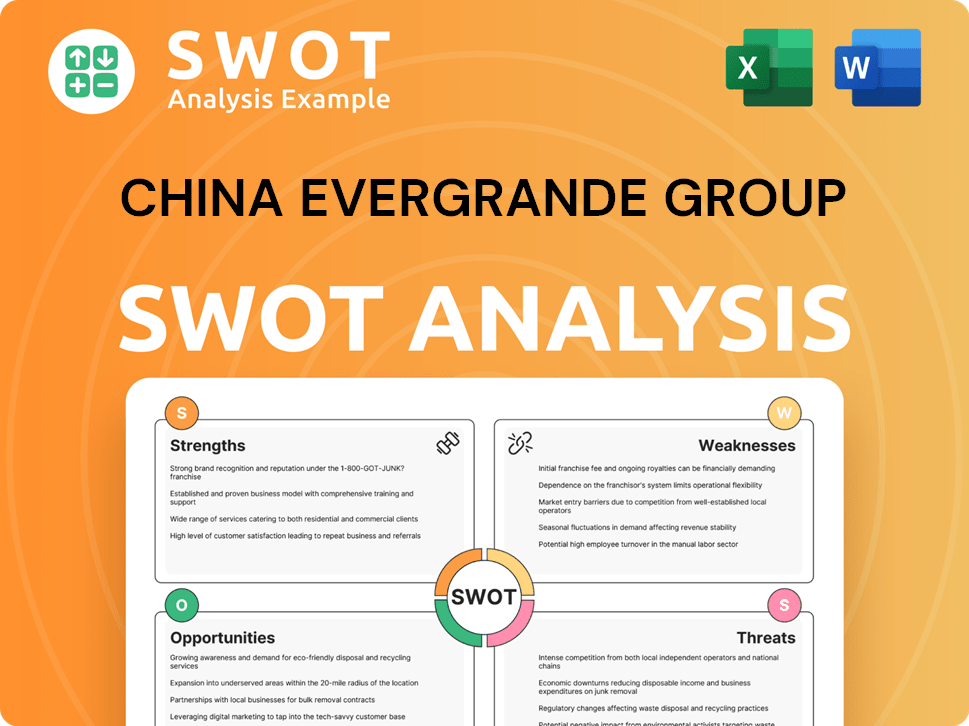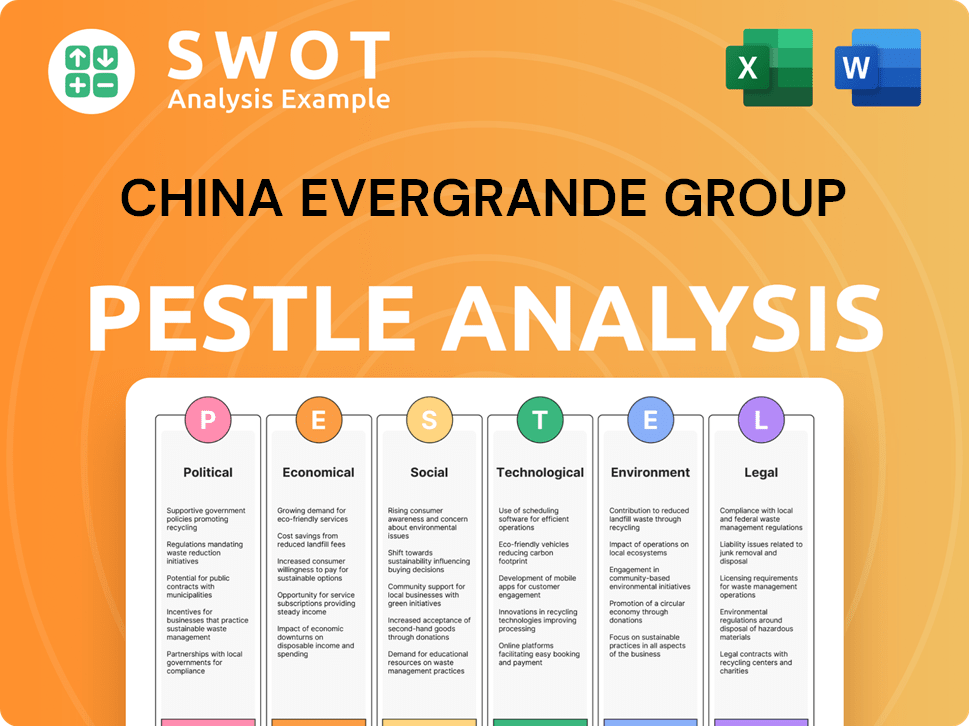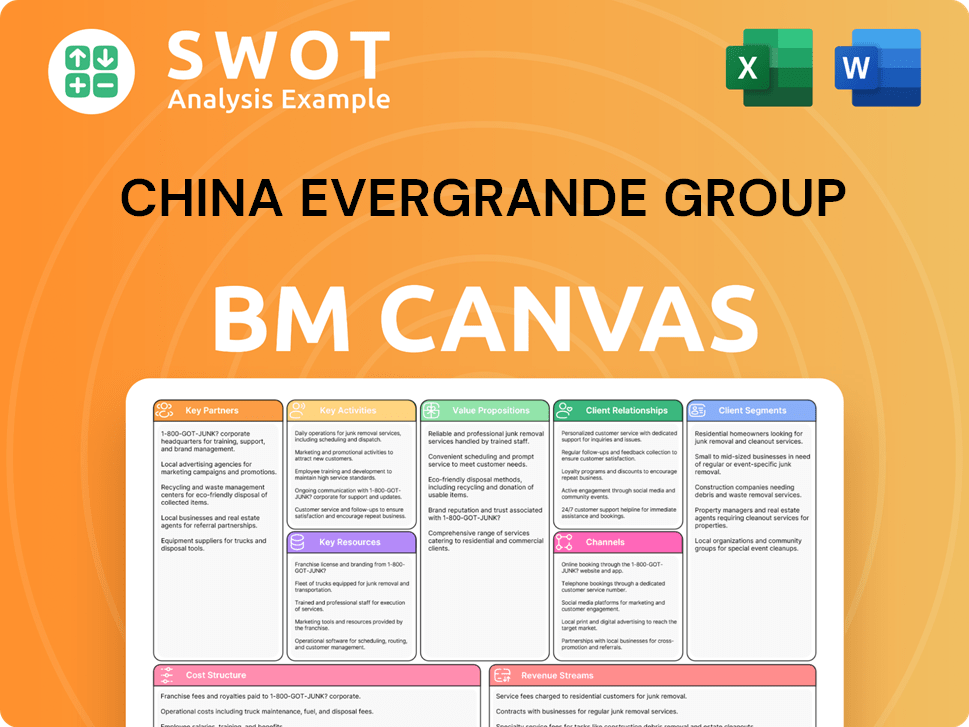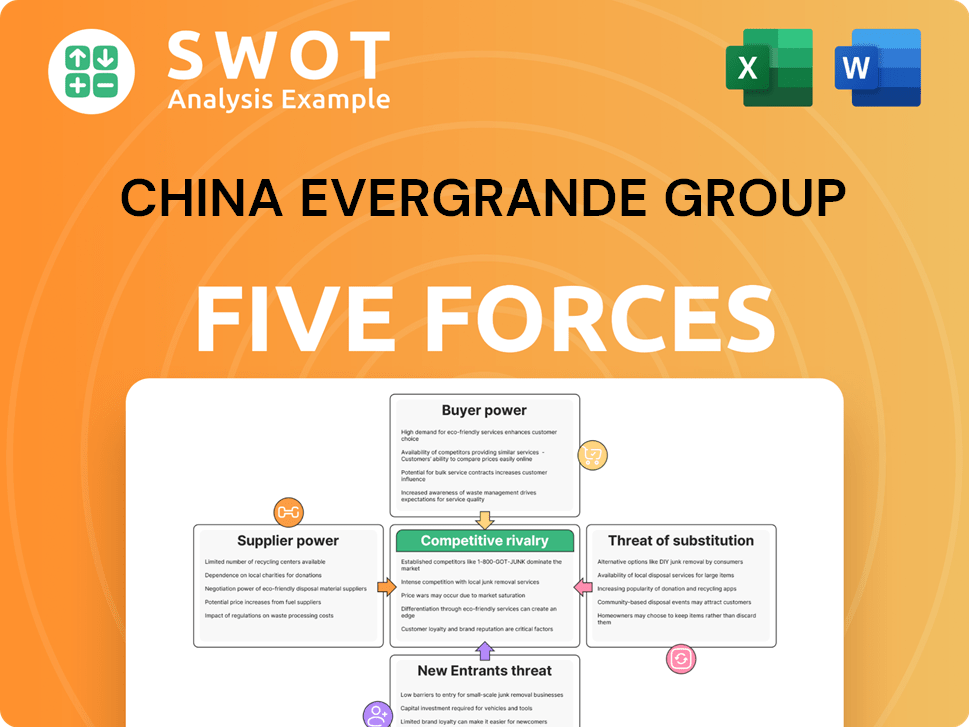China Evergrande Group Bundle
How Did China Evergrande Group's Sales and Marketing Fuel Its Rise and Fall?
Explore the intricate sales and marketing strategies of China Evergrande Group, a real estate giant whose trajectory offers a compelling case study in business success and subsequent financial challenges. From aggressive expansion to innovative sales tactics, Evergrande's approach reshaped the property development landscape in China. Understanding these strategies is crucial for grasping the company's current position and the broader dynamics of the Chinese real estate market.

China Evergrande Group's journey, marked by rapid growth and diversification, was significantly influenced by its China Evergrande Group SWOT Analysis. Its sales and marketing efforts, including a high-volume, pre-selling model, initially drove impressive expansion. This article examines Evergrande's sales performance analysis, marketing campaign examples, and brand positioning, offering insights into the company's evolution and the impact of its strategies on its financial health and market share in China. We will also look at how Evergrande markets its properties and its crisis management strategy.
How Does China Evergrande Group Reach Its Customers?
The sales and marketing strategy of China Evergrande Group, a major player in China's real estate market, heavily relied on a multi-channel approach to reach its extensive customer base. The company primarily used direct sales through its physical sales centers located at development sites. This strategy was complemented by partnerships with property agencies and the increasing use of online platforms to boost its sales and marketing efforts.
The cornerstone of Evergrande's sales model involved establishing large-scale sales centers directly at its project locations. These centers were crucial for showcasing model units, providing detailed information, and finalizing purchase agreements. This offline channel was especially important for their large residential projects, allowing for direct engagement with potential buyers. Additionally, Evergrande utilized a network of real estate agents and brokers to expand its reach across different cities.
The company adapted its sales channels by integrating online platforms, particularly in response to changing market dynamics and technological progress. While physical sales centers remained important, Evergrande increased its use of its official website and partnerships with major Chinese online real estate platforms for property listings, virtual tours, and initial inquiries. This digital adoption aimed to streamline the sales process and cater to a tech-savvy demographic. In 2024, reports indicated Evergrande's efforts to resume some project construction and sales, albeit on a much smaller scale and under immense financial pressure.
Evergrande's primary sales strategy centered on direct sales centers located at its property development sites. These centers offered potential buyers the opportunity to view model units and receive detailed information. This approach allowed for direct interaction and negotiation, which was crucial for high-value real estate transactions.
To broaden its market reach, Evergrande collaborated with a network of third-party real estate agents and brokers. These agencies helped Evergrande access a wider pool of potential buyers across different cities. This strategy was essential for expanding sales beyond the immediate vicinity of its development projects.
Evergrande integrated online platforms into its sales strategy, including its official website and partnerships with major Chinese real estate portals. These platforms were used for property listings, virtual tours, and initial inquiries. This digital presence catered to a tech-savvy demographic and streamlined the sales process.
Evergrande utilized an aggressive pre-sales model, selling units before completion to generate upfront capital. This strategy was risky, as it exposed the company to financial risks if construction lagged or sales faltered. This approach was a key component of their business model, as highlighted in Brief History of China Evergrande Group.
Evergrande's sales strategy combined direct sales with agency partnerships and online platforms to reach a broad customer base. The company's approach evolved to include a significant online presence, leveraging its website and partnerships with major online real estate platforms. The pre-sales model, while effective in generating capital, also carried substantial financial risks.
- Direct Sales Centers: Primary sales channel for direct customer interaction.
- Third-Party Agencies: Expanded market reach through partnerships.
- Online Integration: Streamlined sales process with digital platforms.
- Pre-Sales Model: Generated upfront capital but carried financial risks.
China Evergrande Group SWOT Analysis
- Complete SWOT Breakdown
- Fully Customizable
- Editable in Excel & Word
- Professional Formatting
- Investor-Ready Format

What Marketing Tactics Does China Evergrande Group Use?
The marketing tactics of the China Evergrande Group, historically, were a blend of traditional and digital strategies designed to boost brand awareness and drive sales. The company, during its peak, invested heavily in advertising across various channels, including television, radio, print, and outdoor displays. These efforts were complemented by large-scale promotional events and celebrity endorsements to create excitement and urgency.
In the digital realm, Evergrande utilized content marketing on its website and social media platforms like WeChat and Weibo, providing property information and virtual tours. Paid advertising on online platforms and search engines was also employed to target potential buyers. The company likely used customer segmentation based on demographics and preferences to tailor its marketing messages.
However, the company's marketing mix has evolved significantly, especially in recent years. Due to its financial difficulties, the focus has shifted from aggressive, high-spending campaigns to more targeted efforts aimed at completing existing projects and managing its distressed assets. Current strategies likely center on direct communication with existing buyers and leveraging government support for project delivery rather than broad-based brand building.
Evergrande heavily invested in traditional advertising channels to build brand awareness. This included television commercials, radio spots, and print advertisements in major newspapers and magazines.
Large-scale outdoor billboards and banners were common at construction sites and in urban centers. This strategy aimed to reinforce brand visibility across major cities.
The company frequently organized large-scale promotional events, such as grand opening ceremonies and exclusive sales events. Celebrity endorsements were often used to attract attention.
Evergrande utilized content marketing by providing detailed property information and virtual tours on its official website and social media platforms. Paid advertising was also used.
It can be inferred that Evergrande employed customer segmentation based on demographics, income levels, and property preferences. This helped tailor marketing messages.
With financial challenges, the focus has shifted to more subdued, targeted efforts. These efforts are aimed at completing existing projects and managing its distressed assets.
The Growth Strategy of China Evergrande Group included aggressive marketing campaigns, which were a key component of its Evergrande marketing strategy. These campaigns were designed to support the company's rapid expansion and sales growth. The company's approach to property development in China involved significant investments in marketing to attract buyers to its projects across various cities. Evergrande's sales strategy historically relied on a combination of high-profile advertising and promotional events to drive sales. The company's brand positioning was also crucial in attracting customers. However, the company's financial difficulties have led to a shift in its marketing tactics, with a greater emphasis on completing existing projects. Evergrande's customer relationship management likely played a role in maintaining relationships with existing buyers during this challenging period. The impact of Evergrande on Chinese real estate is significant, and its marketing strategies were a key factor in its market share in China.
China Evergrande Group PESTLE Analysis
- Covers All 6 PESTLE Categories
- No Research Needed – Save Hours of Work
- Built by Experts, Trusted by Consultants
- Instant Download, Ready to Use
- 100% Editable, Fully Customizable

How Is China Evergrande Group Positioned in the Market?
Historically, China Evergrande Group, a major player in Owners & Shareholders of China Evergrande Group, positioned itself as a leading developer of large-scale residential properties. Its focus was on offering quality homes at accessible prices to China's growing urban population. The company aimed to create 'livable communities' by integrating amenities like schools, commercial spaces, and green areas within its developments. This approach formed the foundation of its Evergrande sales strategy.
The brand's visual identity typically conveyed modernity and scale, with a confident and growth-oriented tone. Evergrande's promise to customers was comprehensive living solutions, from property acquisition to post-purchase services, including property management. This emphasis on a complete lifestyle experience was central to its Evergrande marketing strategy.
Evergrande's target audience was primarily reached through a combination of value and aspiration. It offered relatively affordable units within well-planned communities, providing a perceived upgrade in lifestyle. This strategy helped the company capture a significant share of the real estate China market. However, the company's financial difficulties have significantly impacted its brand perception, requiring a shift in its approach.
Evergrande's core message revolved around 'livable communities' and 'quality homes.' This focused on integrated amenities and a comprehensive living experience. The aim was to provide an accessible lifestyle upgrade for China's urban population, emphasizing value and aspiration in its property development China projects.
The brand's visual identity conveyed modernity and scale, with a confident and growth-oriented tone. Promotional materials consistently projected an image of a reliable and expansive developer. This consistency was crucial for maintaining brand recognition and trust within the competitive real estate China market.
Evergrande primarily targeted China's burgeoning urban population, offering properties that appealed to a broad demographic. The company focused on providing accessible homes within well-planned communities, balancing value with a perceived upgrade in lifestyle. Its Evergrande's target audience included first-time homebuyers and those seeking improved living standards.
The company promised comprehensive living solutions, from property acquisition to post-purchase services. This included property management and the integration of amenities within its developments. This focus aimed to create a seamless and convenient experience, enhancing customer satisfaction and loyalty, which was a key part of Evergrande's sales process overview.
The company's financial distress has severely impacted its brand perception. Concerns about project completion and financial stability have emerged. This has necessitated a shift in positioning towards rebuilding trust and demonstrating a commitment to delivering existing projects, often under government intervention. Rebuilding trust is now a priority for Evergrande's brand positioning.
- The company faces challenges in maintaining its brand image.
- Consumer confidence has been shaken by the financial crisis.
- There is a need to reassure customers about project delivery.
- Restructuring efforts are crucial for restoring the brand's reputation.
China Evergrande Group Business Model Canvas
- Complete 9-Block Business Model Canvas
- Effortlessly Communicate Your Business Strategy
- Investor-Ready BMC Format
- 100% Editable and Customizable
- Clear and Structured Layout

What Are China Evergrande Group’s Most Notable Campaigns?
Historically, China Evergrande Group employed aggressive sales and marketing campaigns to boost property sales and expand its market presence. The Evergrande sales strategy frequently revolved around 'golden week' sales events and holiday promotions. These campaigns provided discounts, preferential payment terms, or bundled incentives during major national holidays, aiming to generate a surge in sales within a short timeframe.
These campaigns were heavily promoted through traditional media, such as TV and print, along with digital channels, including the company website and social media. Advertising often highlighted the limited-time nature of the offers and the aspirational lifestyle associated with Evergrande properties. Collaborations with celebrities were also a common feature, boosting brand visibility and credibility. The effectiveness of these tactics is evident in the company's rapid growth and high sales volumes during its peak years.
However, from 2021 onwards, the company's focus shifted dramatically due to its financial crisis. The Evergrande marketing strategy transitioned from driving new sales to ensuring the completion and delivery of existing housing projects, known as 'guaranteeing delivery' (保交楼). This shift reflects a move from sales-driven strategies to crisis management and rebuilding trust by fulfilling existing obligations.
These were a cornerstone of the Evergrande sales strategy. They involved significant discounts and incentives during national holidays. The objective was to generate a rapid increase in sales volume.
Celebrity endorsements were used to enhance brand visibility. They aimed to boost credibility among the general public. This approach helped in increasing sales and market share.
Digital channels, including the company website and social media, were used. These platforms promoted sales events and new property launches. The goal was to reach a wider audience.
Post-crisis, the focus shifted to completing existing projects. This involved securing funding and coordinating with stakeholders. The goal was to restore trust.
The shift in Evergrande's business model reflects a change in its approach to real estate in China. Instead of primarily focusing on sales, the company concentrated on fulfilling its existing commitments. This involved extensive efforts to ensure the completion of stalled housing projects. These actions were largely driven by local governments, highlighting the complex interplay between the company and regulatory bodies. The current situation necessitates a focus on financial restructuring and operational adjustments, as detailed in this article about China Evergrande Group: 0.
China Evergrande Group Porter's Five Forces Analysis
- Covers All 5 Competitive Forces in Detail
- Structured for Consultants, Students, and Founders
- 100% Editable in Microsoft Word & Excel
- Instant Digital Download – Use Immediately
- Compatible with Mac & PC – Fully Unlocked

Related Blogs
- What are Mission Vision & Core Values of China Evergrande Group Company?
- What is Competitive Landscape of China Evergrande Group Company?
- What is Growth Strategy and Future Prospects of China Evergrande Group Company?
- How Does China Evergrande Group Company Work?
- What is Brief History of China Evergrande Group Company?
- Who Owns China Evergrande Group Company?
- What is Customer Demographics and Target Market of China Evergrande Group Company?
Disclaimer
All information, articles, and product details provided on this website are for general informational and educational purposes only. We do not claim any ownership over, nor do we intend to infringe upon, any trademarks, copyrights, logos, brand names, or other intellectual property mentioned or depicted on this site. Such intellectual property remains the property of its respective owners, and any references here are made solely for identification or informational purposes, without implying any affiliation, endorsement, or partnership.
We make no representations or warranties, express or implied, regarding the accuracy, completeness, or suitability of any content or products presented. Nothing on this website should be construed as legal, tax, investment, financial, medical, or other professional advice. In addition, no part of this site—including articles or product references—constitutes a solicitation, recommendation, endorsement, advertisement, or offer to buy or sell any securities, franchises, or other financial instruments, particularly in jurisdictions where such activity would be unlawful.
All content is of a general nature and may not address the specific circumstances of any individual or entity. It is not a substitute for professional advice or services. Any actions you take based on the information provided here are strictly at your own risk. You accept full responsibility for any decisions or outcomes arising from your use of this website and agree to release us from any liability in connection with your use of, or reliance upon, the content or products found herein.